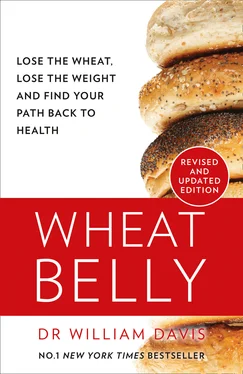Sumerians, credited with developing the first written language, left us tens of thousands of cuneiform tablets. Pictographic characters, dated to 3000 BC, describe recipes for breads and pastries, all made by taking mortar and pestle or hand-pushed grinding wheel to emmer wheat. Sand was often added to the mixture to hasten the laborious grinding process, leaving bread-eating Sumerians with sand-chipped teeth.
Emmer wheat flourished in ancient Egypt, its cycle of growth suited to the seasonal rise and fall of the Nile. Egyptians are credited with learning how to make bread “rise” by the addition of yeast. When the Jews fled Egypt, in their hurry they failed to take the leavening mixture with them, forcing them to consume unleavened bread made from emmer wheat.
Sometime in the millennia predating Biblical times, twenty-eight-chromosome emmer wheat ( Triticum turgidum ) mated naturally with another grass, Triticum tauschii , yielding primordial forty-two-chromosome Triticum aestivum , genetically closer to what we now call wheat. Because it contains the sum total of the chromosomal content of three unique grasses with forty-two chromosomes, it is the most genetically complex. It is therefore the most genetically “pliable,” an issue that will serve future genetics researchers well in the millennia to come.
Over time, the higher yielding and more baking-compatible Triticum aestivum species gradually overshadowed its parents, einkorn and emmer wheat. In the ensuing centuries, Triticum aestivum wheat changed little. By the mid-eighteenth century, the great Swedish botanist and biological cataloger, Carolus Linnaeus, father of the Linnean system of the categorization of species, counted five different varieties falling under the Triticum genus.
Wheat did not evolve naturally in the New World, but was introduced by Christopher Columbus, whose crew first planted a few grains in Puerto Rico in 1493. Spanish explorers accidentally brought wheat seeds in a sack of rice to Mexico in 1530, and later introduced it to the American Southwest. The namer of Cape Cod and discoverer of Martha’s Vineyard, Bartholomew Gosnold, first brought wheat to New England in 1602, followed shortly thereafter by the Pilgrims, who transported wheat with them on the Mayflower.
WILL THE REAL WHEAT PLEASE STAND UP?
What was the wheat grown ten thousand years ago and harvested by hand from wild fields like? That simple question took me to the Middle East—or more precisely, to a small organic farm in western Massachusetts.
There I found Elisheva Rogosa. Eli is not only a science teacher but an organic farmer, advocate of sustainable agriculture, and founder of the Heritage Grain Conservancy (www.growseed.org), an organization devoted to preserving ancient food crops and cultivating them using organic principles. After living in the Middle East for ten years and working with the Jordanian, Israeli, and Palestinian GenBank project to collect nearly extinct ancient wheat strains, Eli returned to the United States with seeds descended from the original wheat plants of ancient Egypt and Canaan. She has since devoted herself to cultivating the ancient grains that sustained her ancestors.
My first contact with Eli began with an exchange of e-mails that resulted from my request for 2 pounds of einkorn wheat grain. She couldn’t stop herself from educating me about her unique crop, which was not just any old wheat grain, after all. Eli described the taste of einkorn bread as “rich, subtle, with more complex flavor,” unlike bread made from modern wheat flour that she believes tastes like cardboard.
Eli bristles at the suggestion that wheat products might be unhealthy, citing instead the yield-increasing, profit-expanding agricultural practices of the past few decades as the source of the adverse health effects of wheat. She views einkorn and emmer as the solution, restoring the original grasses, grown under organic conditions, to replace modern industrial wheat.
And so it went, a gradual expansion of the reach of wheat plants with only modest and continual evolutionary selection at work.
Today einkorn, emmer, and the original wild and cultivated strains of Triticum aestivum have been replaced by thousands of modern human-bred offspring of Triticum aestivum , as well as Triticum durum (pasta) and Triticum compactum (yielding very fine flours used to make cupcakes and other products). To find einkorn or emmer today, you’d have to look for the limited wild collections or modest human plantings scattered around the Middle East, southern France, northern Italy, or Eli Rogosa’s farm. Courtesy of modern human-managed hybridizations and other genetic manipulations, Triticum species of today are thousands of genes apart from the original einkorn wheat that grew naturally, farther apart than you are from the primates hanging from trees in the zoo.
Modern Triticum wheat is the product of breeding to generate greater yield and characteristics such as disease, drought, and heat resistance. In fact, wheat has been modified by humans to such a degree that modern strains are unable to survive in the wild without human support such as nitrate fertilization and pest control. 8(Imagine this bizarre situation in the world of domesticated animals: an animal able to exist only with human assistance, such as special feed or antibiotics, else it would die.)
Differences between the wheat of the Natufians and what we call wheat in the twenty-first century are evident to the naked eye. Original einkorn and emmer wheat were “hulled” forms, simply meaning that the seeds clung tightly to the stem. Modern wheats are “naked” forms, in which the seeds depart from the stem more readily, a characteristic that makes threshing (separating the seed from the chaff) easier, determined by mutations at the Q and Tg ( tenacious glume ) genes. 9But other differences are even more obvious. Modern wheat is much shorter. The romantic notion of tall fields of wheat grain gracefully waving in the wind has been replaced by “dwarf” and “semi-dwarf” varieties that stand barely a foot or two tall, yet another product of breeding experiments to increase yield and reflecting the extensive genetic changes that this grass has undergone.
SMALL IS THE NEW BIG
For as long as humans have practiced agriculture, farmers have strived to increase yield. Marrying a woman with a dowry of several acres of farmland was, for many centuries, the primary means of increasing crop yield, arrangements often accompanied by several goats and a sack of potatoes. The twentieth century introduced mechanized farm machinery that replaced animal power and increased efficiency, providing another incremental increase in yield per acre. While production in the United States was usually sufficient to meet demand (with distribution limited more by poverty than by supply), many other nations were unable to feed their populations, resulting in widespread hunger.
In modern times, humans have tried to increase yield by creating new strains, crossbreeding different wheats and grasses and generating new genetic varieties in the laboratory. Hybridization efforts involved techniques such as introgression and “back-crossing,” in which offspring of plant breeding are mated with their parents or with different strains of wheat or even other grasses. Such efforts, though first formally described by Austrian priest and botanist Gregor Mendel in 1866, did not begin in earnest until the mid-twentieth century, when concepts such as heterozygosity and gene dominance were better understood. Since Mendel’s early efforts, geneticists have developed elaborate techniques to obtain a desired trait, though much trial and error is still required.
Читать дальше












